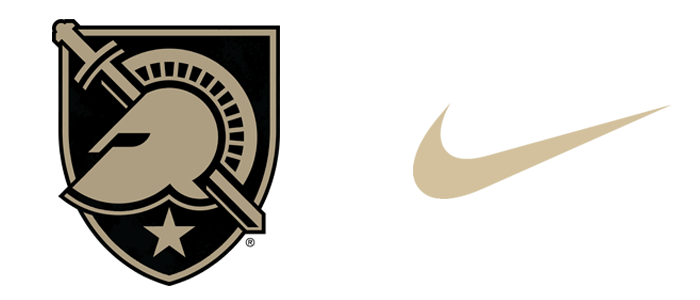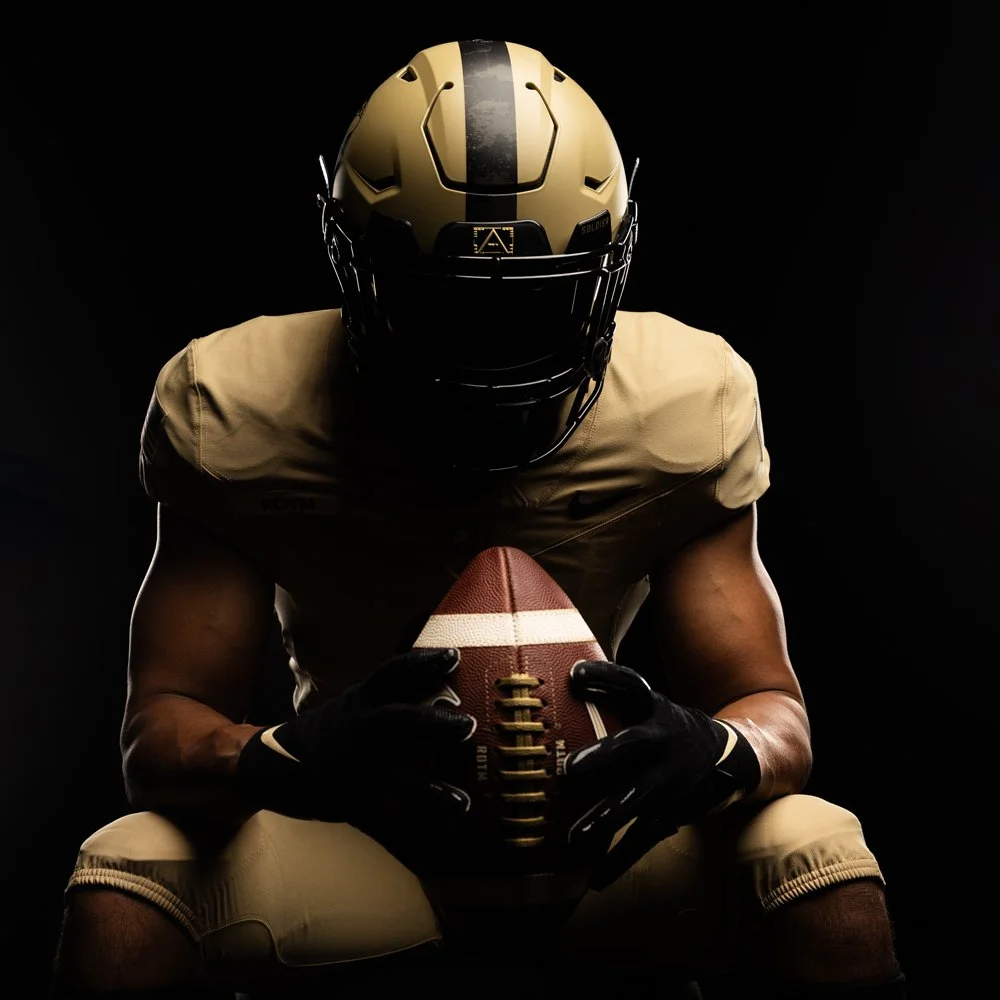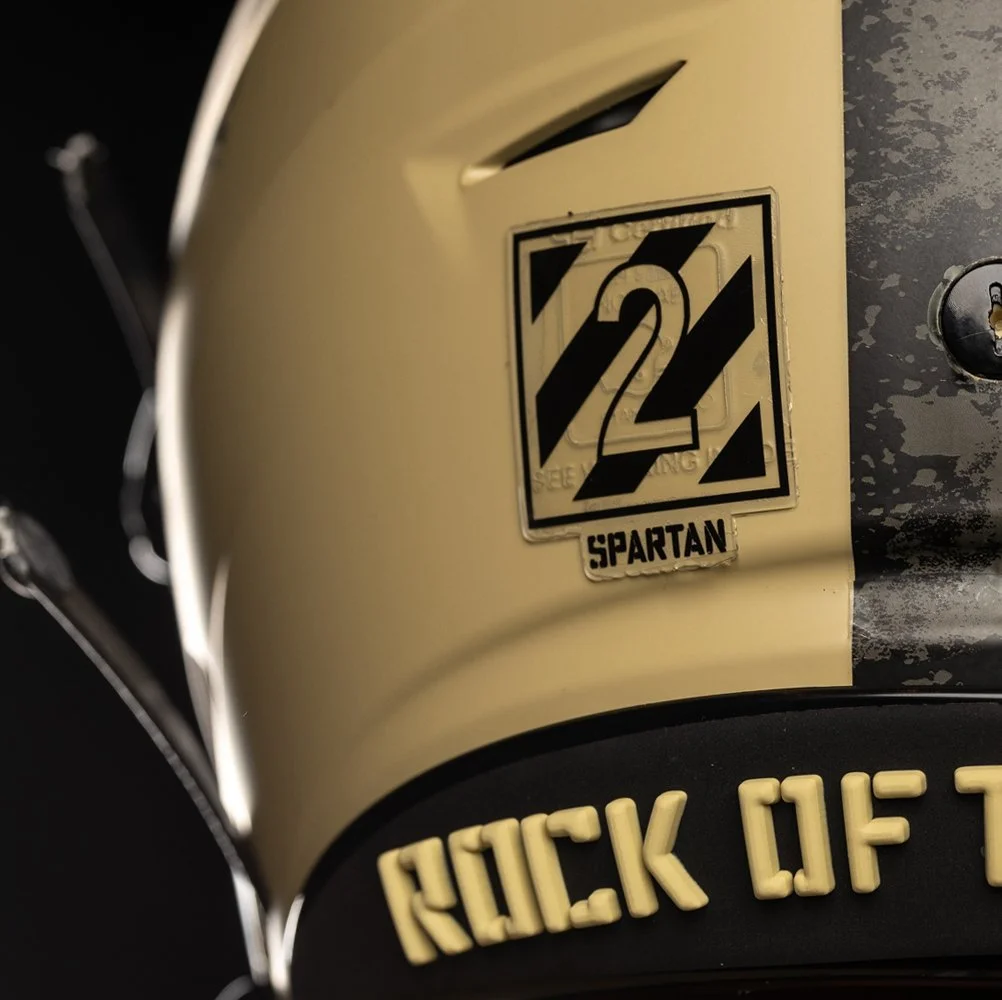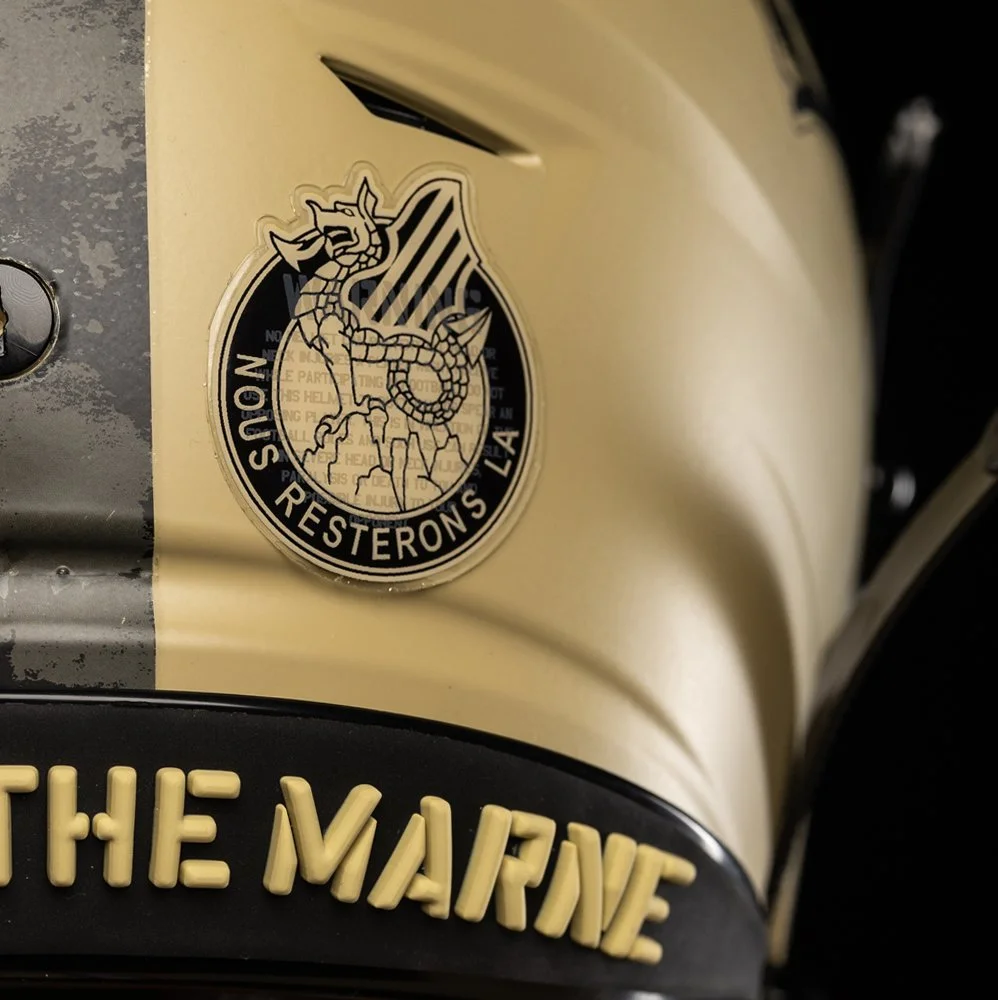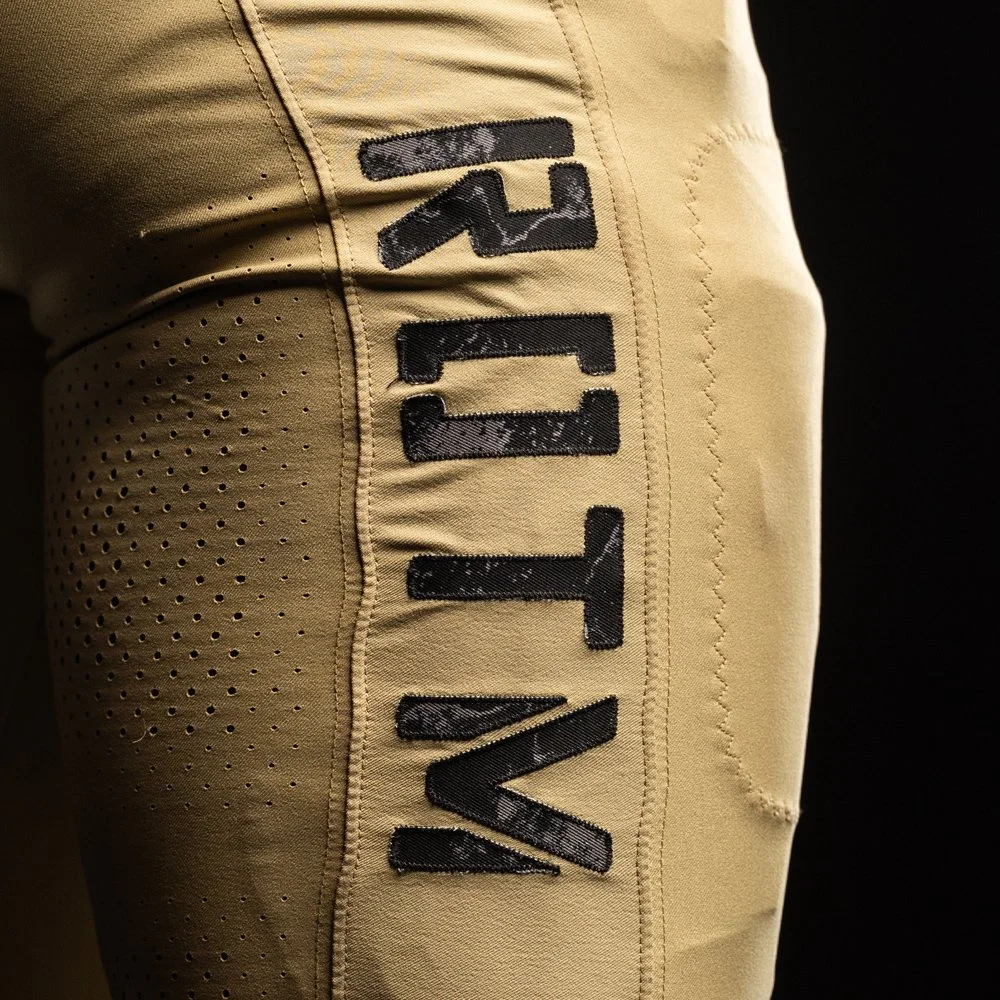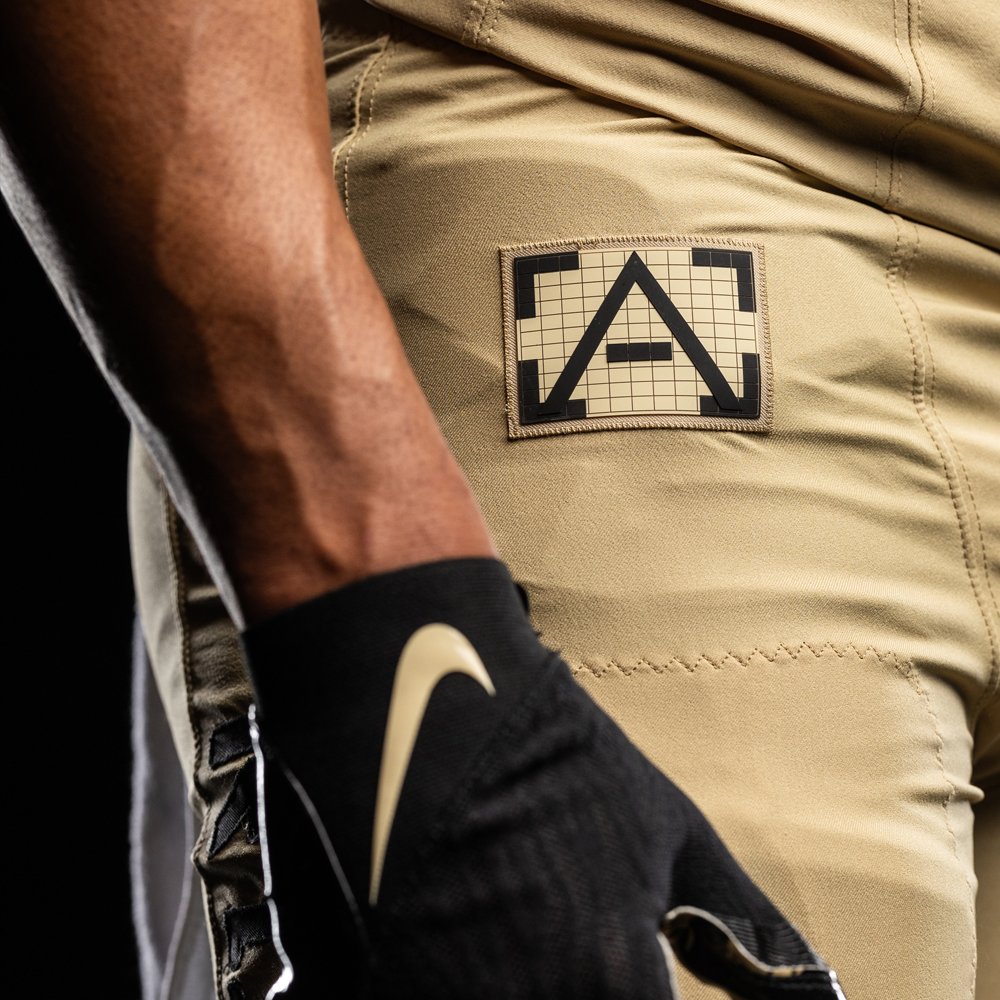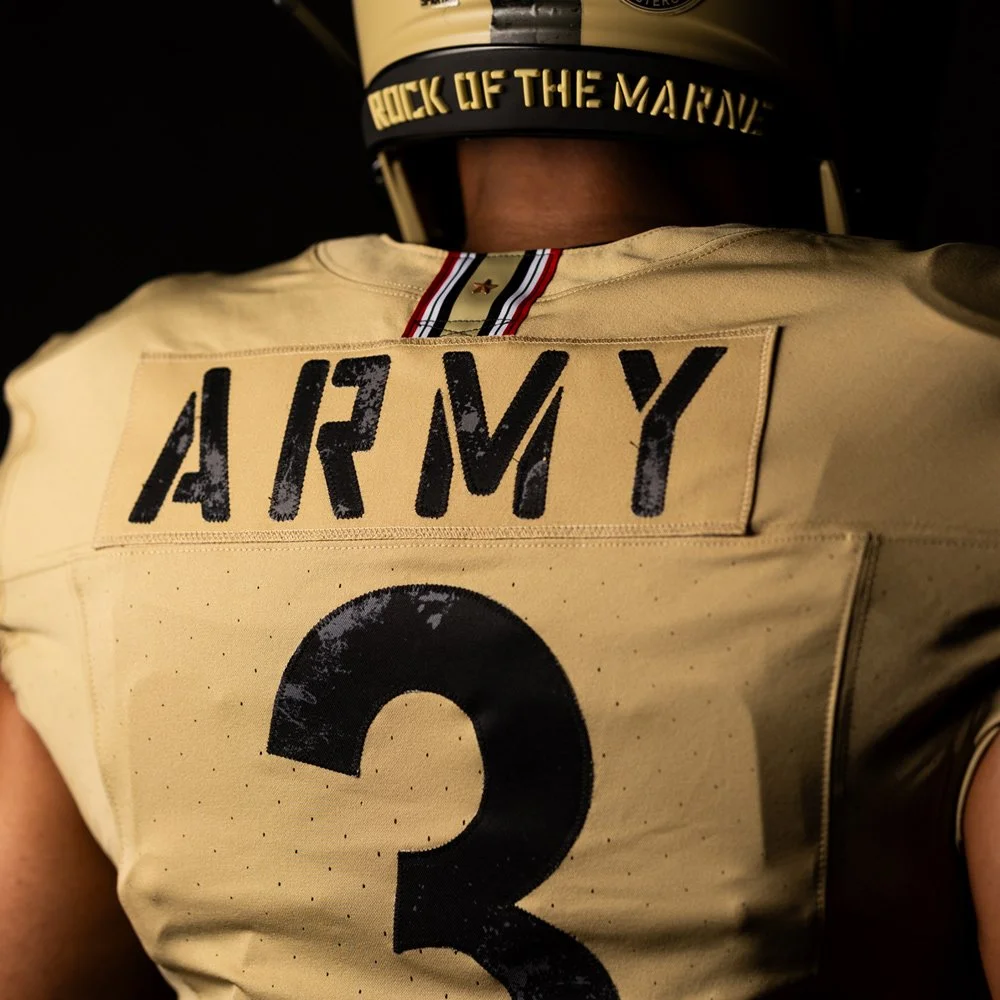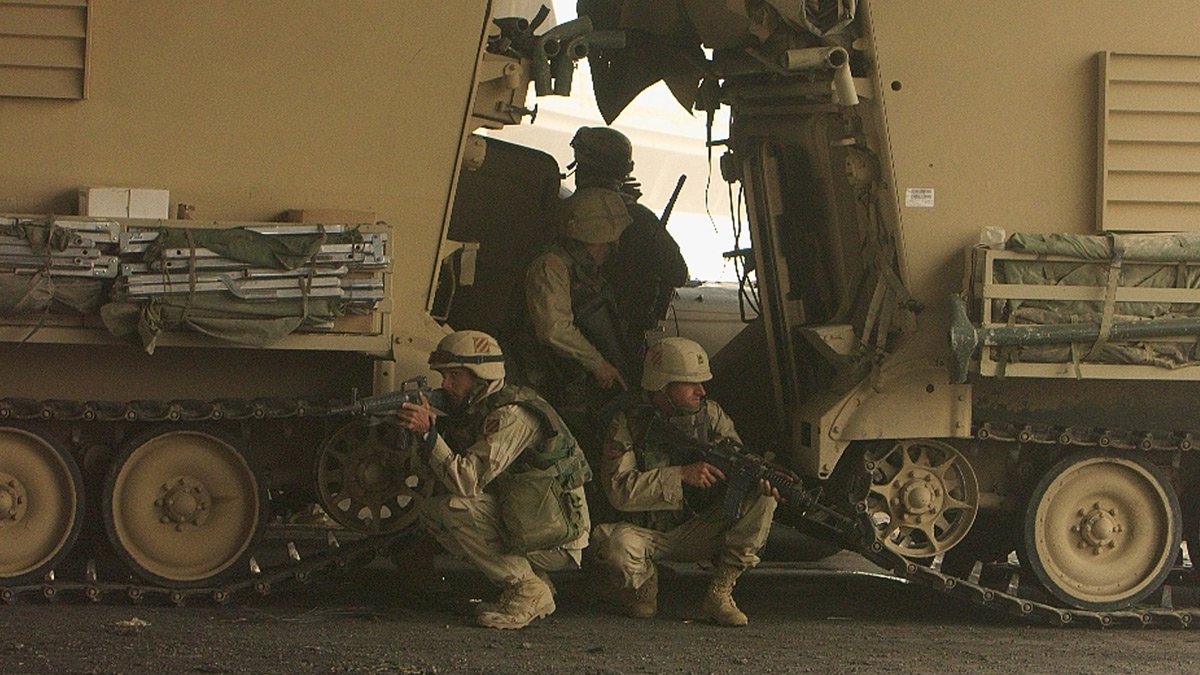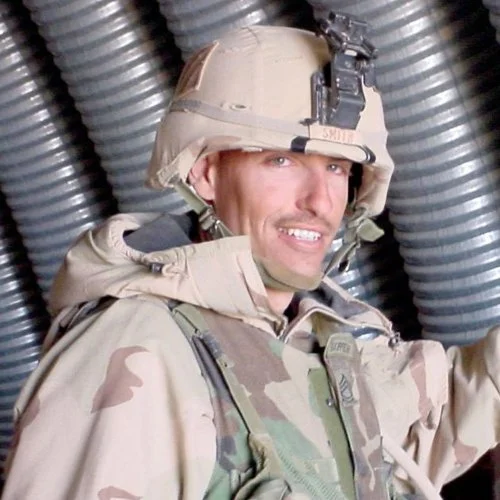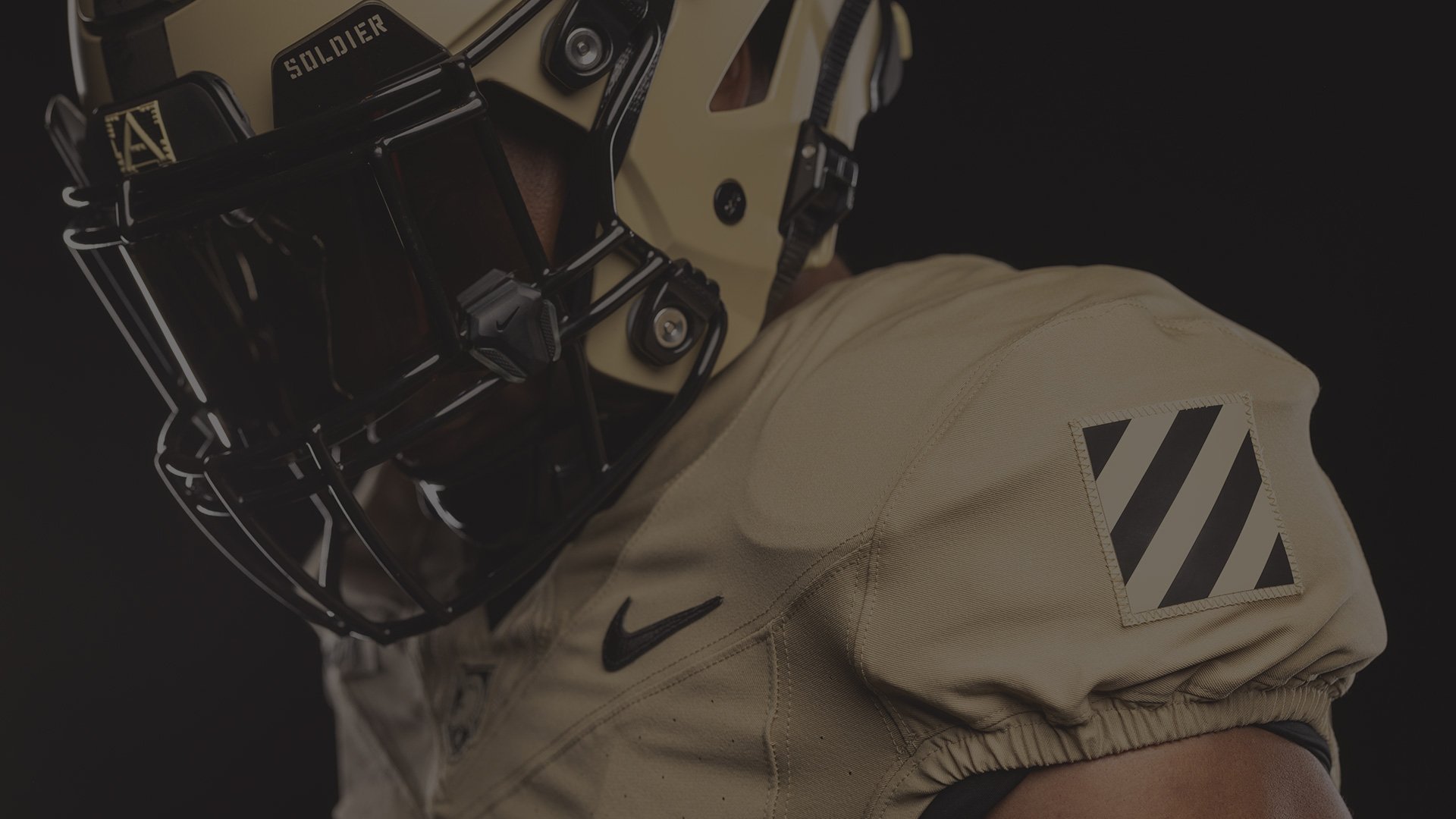
ARMY AND NIKE TEAM UP FOR 2023 ARMY-NAVY UNIFORM TO HONOR THE SOLDIERS OF THE 3RD INFANTRY DIVISION
DogFace Soldiers
The 2023 Army-Navy uniform tells the story of the soldiers of the 3rd Infantry Division during the opening phase of Operation Iraqi Freedom (OIF). This year marks the 20th anniversary of the Marne Division’s participation in the initiation of offensive operations in Iraq, the longest and most rapid armored advance since the Second World War.
The 3rd Infantry Division’s success hinged upon its ability to seize and maintain the initiative against a determined adversary in harsh and unforgiving terrain. The Dogface Soldiers of the 3rd Infantry Division accomplished this feat through clear application of the U.S. Army’s characteristics of the offensive: surprise, concentration, audacity, and tempo.
On December 9, we are honored to represent the soldiers of the 3rd Infantry Division and their tactical acumen on the field in Foxborough. In adopting their mottos, symbols, and ethos on the field of friendly strife, we seek to emulate their application of these characteristics to defeat our rivals.

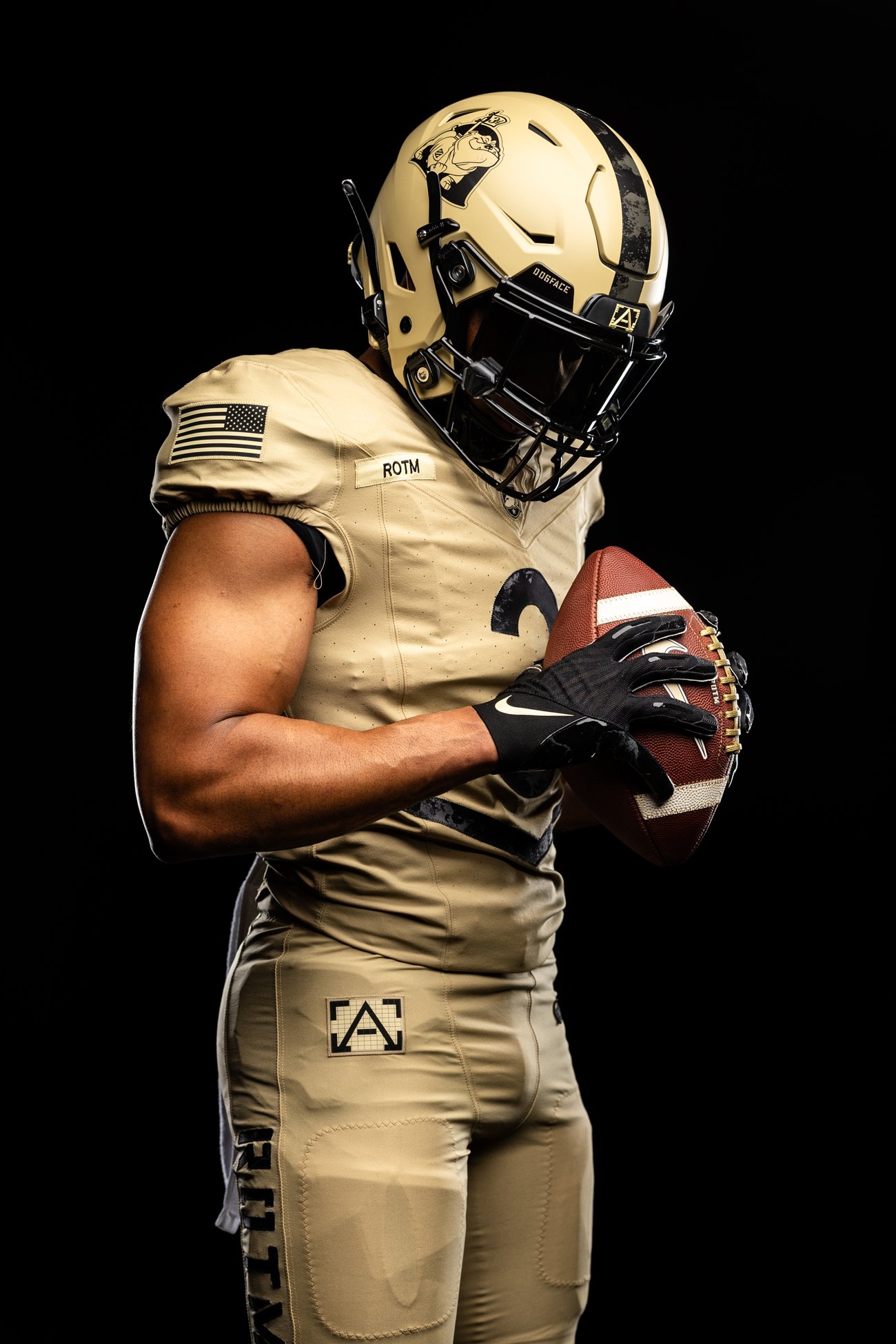
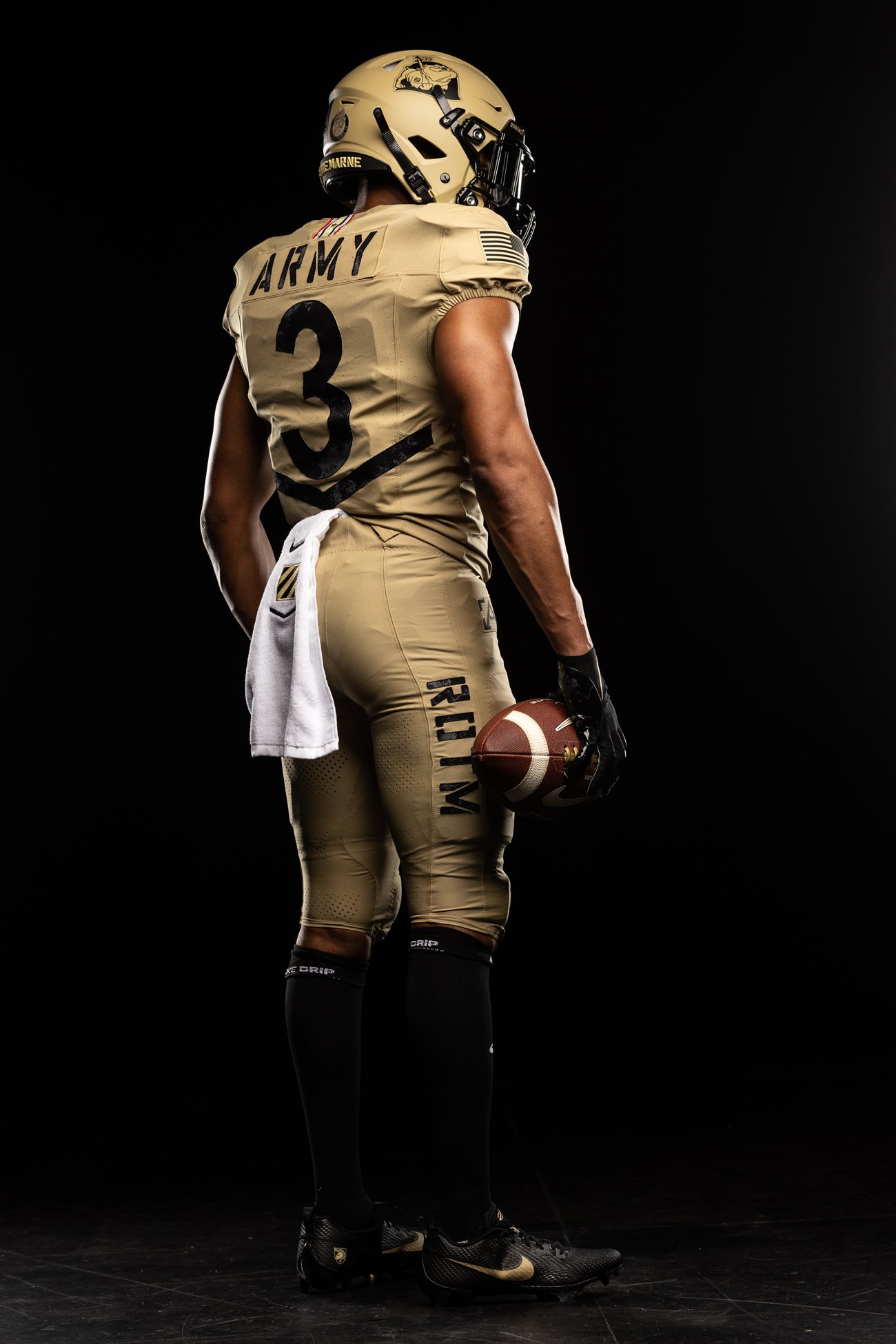
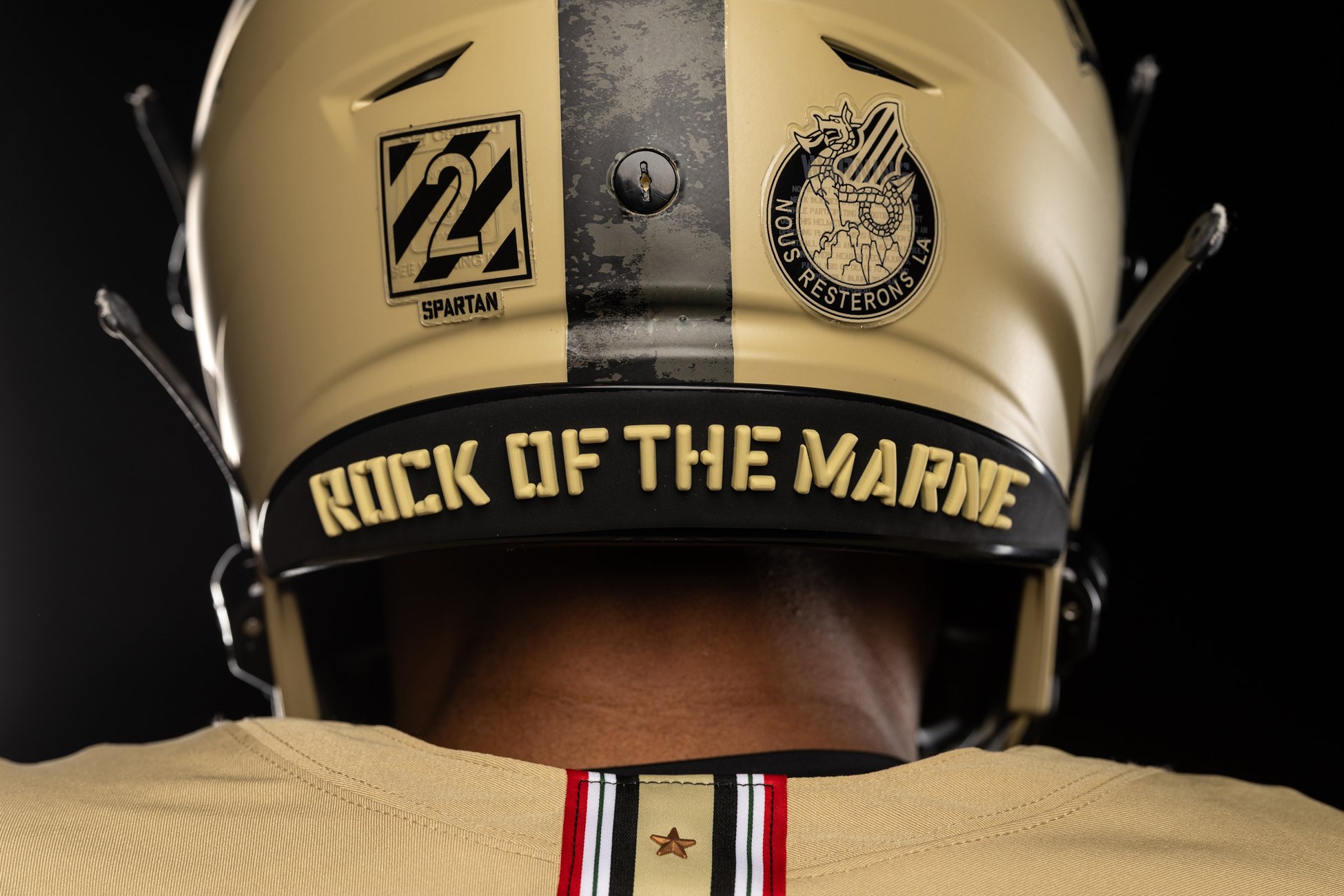

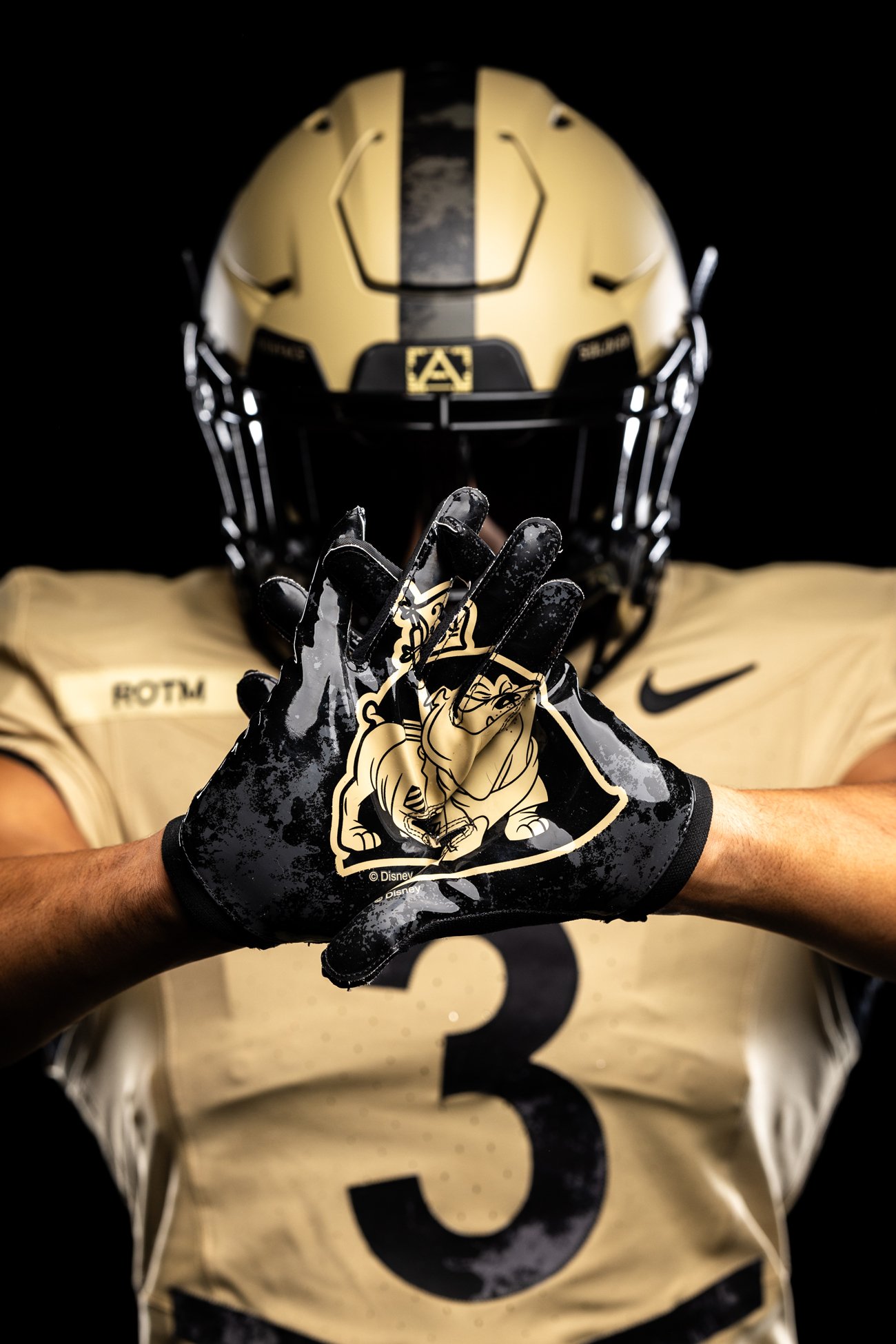
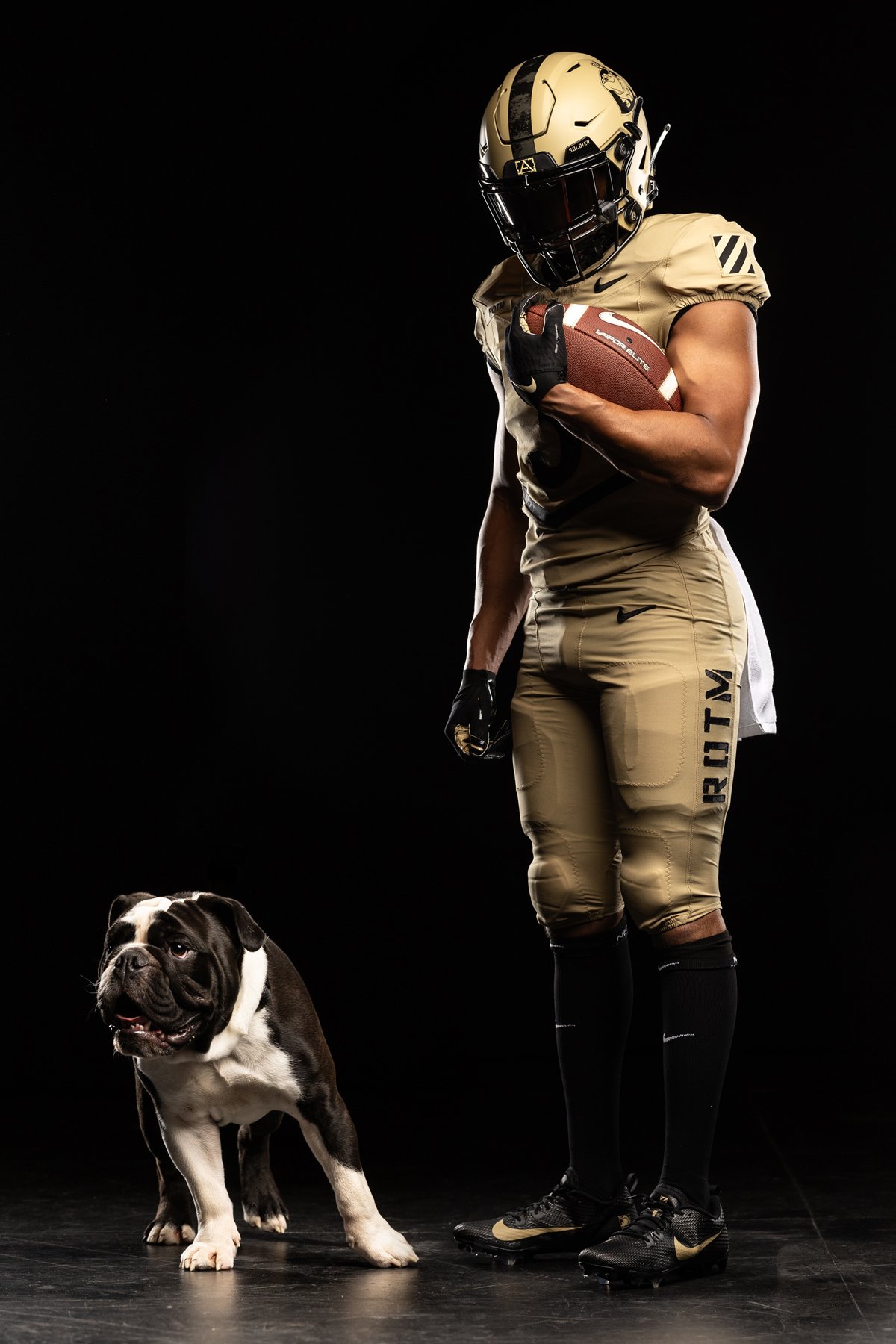
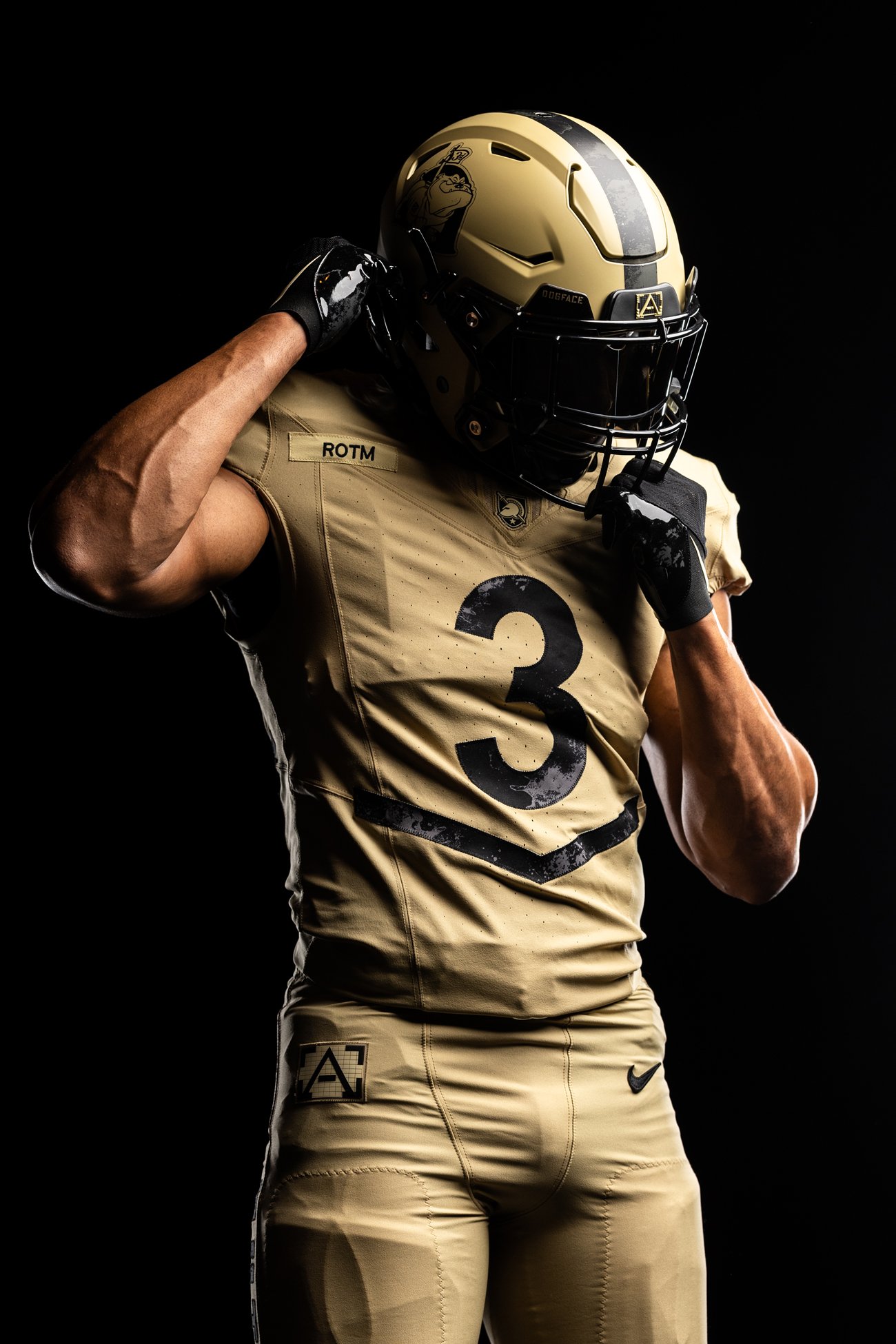
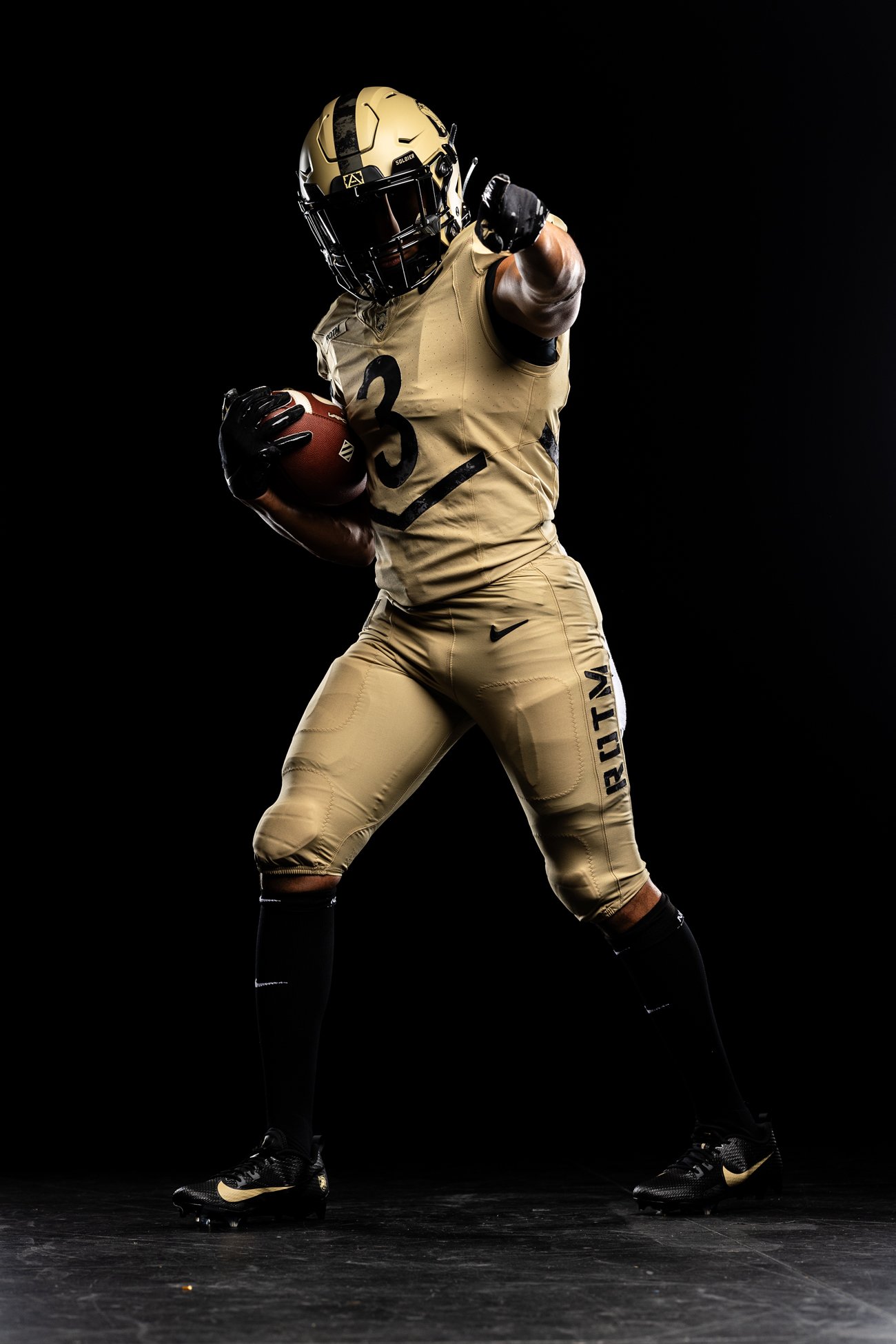


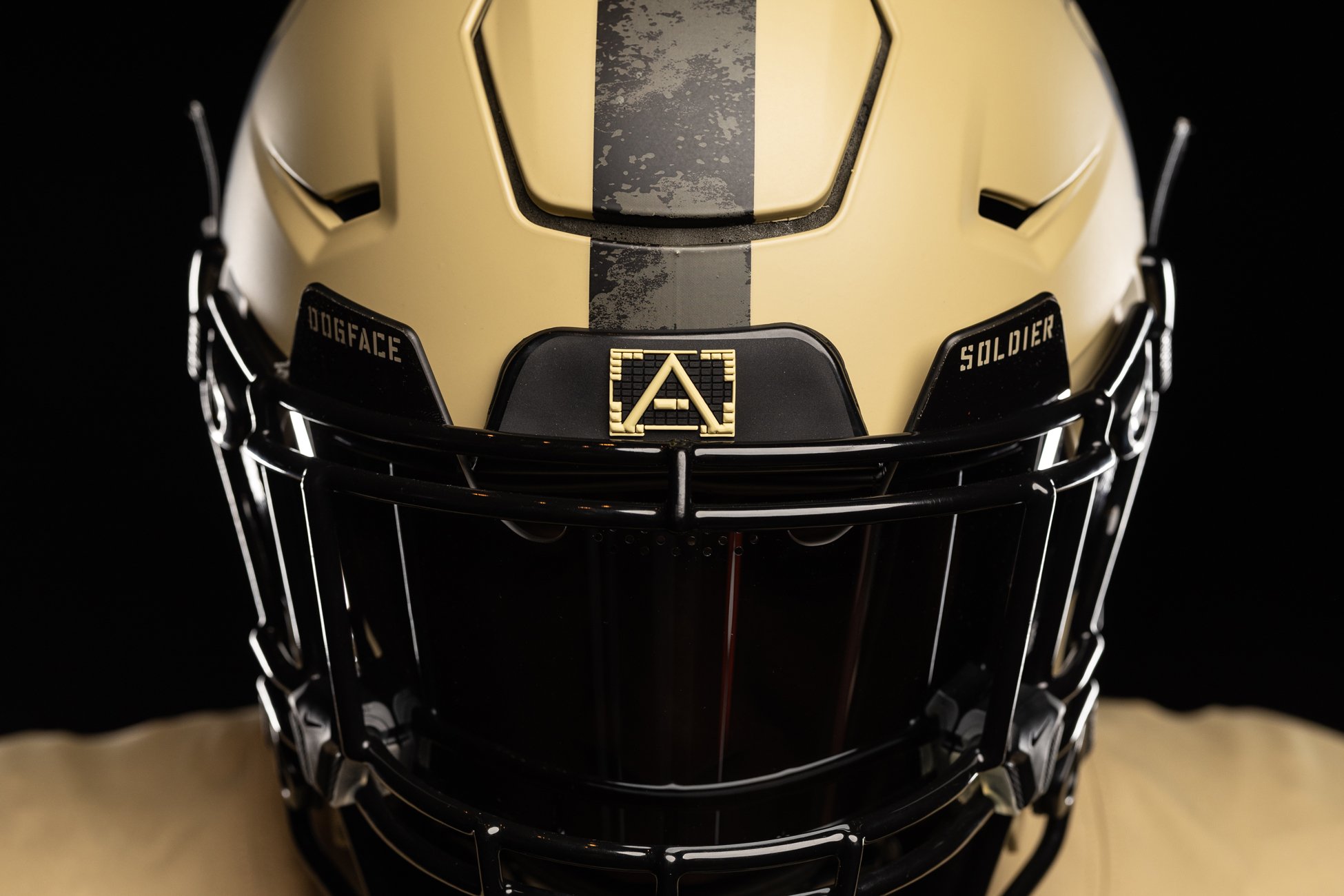
Operation Iraqi Freedom (OIF) / Thunder Runs (1 and 2)
The 3rd Infantry Division conducted extensive training in Kuwait prior to the invasion of Iraq in the early hours of March 21, 2003. As part of a broader land campaign, the 3rd Infantry Division – the tip of the armored spearhead – defeated regular and irregular Iraqi forces as it advanced through the towns of Nasiriyah, Samawah, and Najaf and then through the Karbala Gap. After moving through the Karbala Gap, the 3rd Infantry Division’s 1st Brigade Combat Team seized the Baghdad Airport, which isolated the Iraqi capital from the south and west.
“Figure – 70.33 March on Baghdad, 21 March – 9 April © from The West Point History of Warfare, ed. Clifford J. Rogers and Ty Seidule.
In an effort to maintain pressure on the Iraqi regime and determine the strength of the Iraqi defenses in and around Baghdad, Major General (MG) Buford Blount, commanding general of the 3rd Infantry Division, ordered 2nd Brigade Combat Team, under the command of Colonel (COL) David Perkins, to conduct an armored thrust north along Highway 8 into central Baghdad before moving southwest to return to the Baghdad International Airport. This operation came to be known as the Thunder Run.
COL Perkins gave the mission to Task Force (TF) 1-64 Armor Battalion, under the command of Lieutenant Colonel (LTC) Rick Schwartz. LTC Schwartz chose to use the battalion’s main combat power, consisting of 29 M1 Abrams tanks and 14 M2 Bradley Fighting Vehicles, along with numerous M113 armored personnel carriers to discover the enemy’s disposition, strength, and determination to fight. On April 5, 2003, as the armored spearhead probed western Baghdad, LTC Schwartz’s soldiers received heavy fire from uncoordinated Iraqi paramilitary forces before moving to join other elements of the 3rd Infantry Division at the Baghdad airport. The first Thunder Run was an unqualified success that demonstrated the Army’s presence and freedom to maneuver in Baghdad.
Two days later 2nd Brigade Combat Team was tasked to attack into central Baghdad to maintain the initiative, demonstrate American resolve, and counter Iraqi propaganda claiming American forces were not near Baghdad. This time, the entire 2nd Brigade Combat Team participated in what was named the second Thunder Run, resulting in the brigade occupying key infrastructure in the heart of Baghdad and ultimately breaking the will of the Iraqi regime. The efforts of 2nd Brigade Combat Team, and those with them, during the Thunder Runs demonstrated their competence, selfless service, and “Send Me” attitude.
Thunder Run
2023 Uniform Inspired Features
THE DIVISION ORIGINS
The 3rd Infantry Division was activated on November 21, 1917, and organized at Camp Greene, North Carolina prior to arriving in France in April 1918 for service in World War I as part of the American Expeditionary Forces (AEF).
The division saw combat in France on the Western Front, distinguishing itself in July 1918 during the Second Battle of the Marne, earning the nickname “Rock of the Marne” and its motto, “Nous resterons Là” (we shall remain there). Elements of the division, positioned on the banks of the Marne River, held back advancing German forces near Château-Thierry that were driving rapidly towards Paris. The division was instrumental during the subsequent St. Mihiel and Meuse-Argonne offensives, aiding in the defeat of Imperial Germany. During World War II, the division served in North Africa, Sicily, Italy, France, Germany, and Austria, experiencing some of the fiercest combat in the Mediterranean and European Theaters of Operations. The division participated in four amphibious operations during the war, demonstrating its capability as an organization in a variety of conditions and environments.
As the Cold War turned hot on the Korean Peninsula, elements the 3rd Infantry Division, known as the “fire brigade” of the Eighth Army, was called upon to stem the advance of communist aggression from North Korea and China from 1950 until the Korean War’s conclusion in 1953. Elements of the division were integral during Operation Desert Storm in 1991 as part of the Allied Coalition that successfully defeated Iraqi forces after their invasion of Kuwait in 1990.
After the division re-located to Fort Stewart, Georgia in 1996, the 3rd Infantry Division joined the XVIII Airborne Corps and participated in numerous peacekeeping operations in Kuwait, Egypt, Bosnia, Croatia, and Kosovo. After the terrorist attacks on September 11, 2001, the division’s soldiers deployed multiple times to Iraq and Afghanistan, demonstrating their readiness to answer our nation’s call.
Featured Brigades of the 3rd Infantry Division
-

1st Brigade
The Raider Brigade was first activated in 1917 to deploy to France during World War I, and has since conducted combat operations in Korea, Iraq, and Afghanistan. During the assault into Baghdad, 1st Brigade led the attack to seize Baghdad International Airport from a brigade of Iraqi Special Republican Guard and Iraqi Special Forces. Seizing the Baghdad International Airport protected 2nd Brigade as it staged for the Thunder Runs. Committed to their motto, “Raiders First,” the brigade’s soldiers stand ready to redeploy for future missions.
-

2nd Brigade
The Spartan Brigade was founded in 1917, and participated in combat deployments during World War I, World War II, the Korean War, and the Iraq War. During the invasion of Iraq, the Brigade penetrated Baghdad in two Thunder Runs, which provided the 3rd Infantry Division with key information about the composition and disposition of enemy forces and facilitated the coalition occupation of central Baghdad. The unit’s bravery in combat directly contributed to the collapse of enemy resistance. When the Army asks, “who shall we send?” the 2nd Brigade proudly proclaims, “Send Me!”
-

3rd Brigade
The Sledgehammer Brigade traces its lineage to the 6th Infantry Brigade, first activated in 1917 to participate in the 3rd Infantry Division’s World War I campaigns. Following the first Thunder Run, 3rd Brigade helped secure the northern flank of the 3rd Infantry Division by seizing bridges from Iraqi Republican Guard and Fedayeen units. This prevented external reinforcements from attacking 2nd Brigade during the second Thunder Run, while also preventing Iraqi conventional forces from retreating in good order.
Additional Featured Units of the 3rd Infantry Division
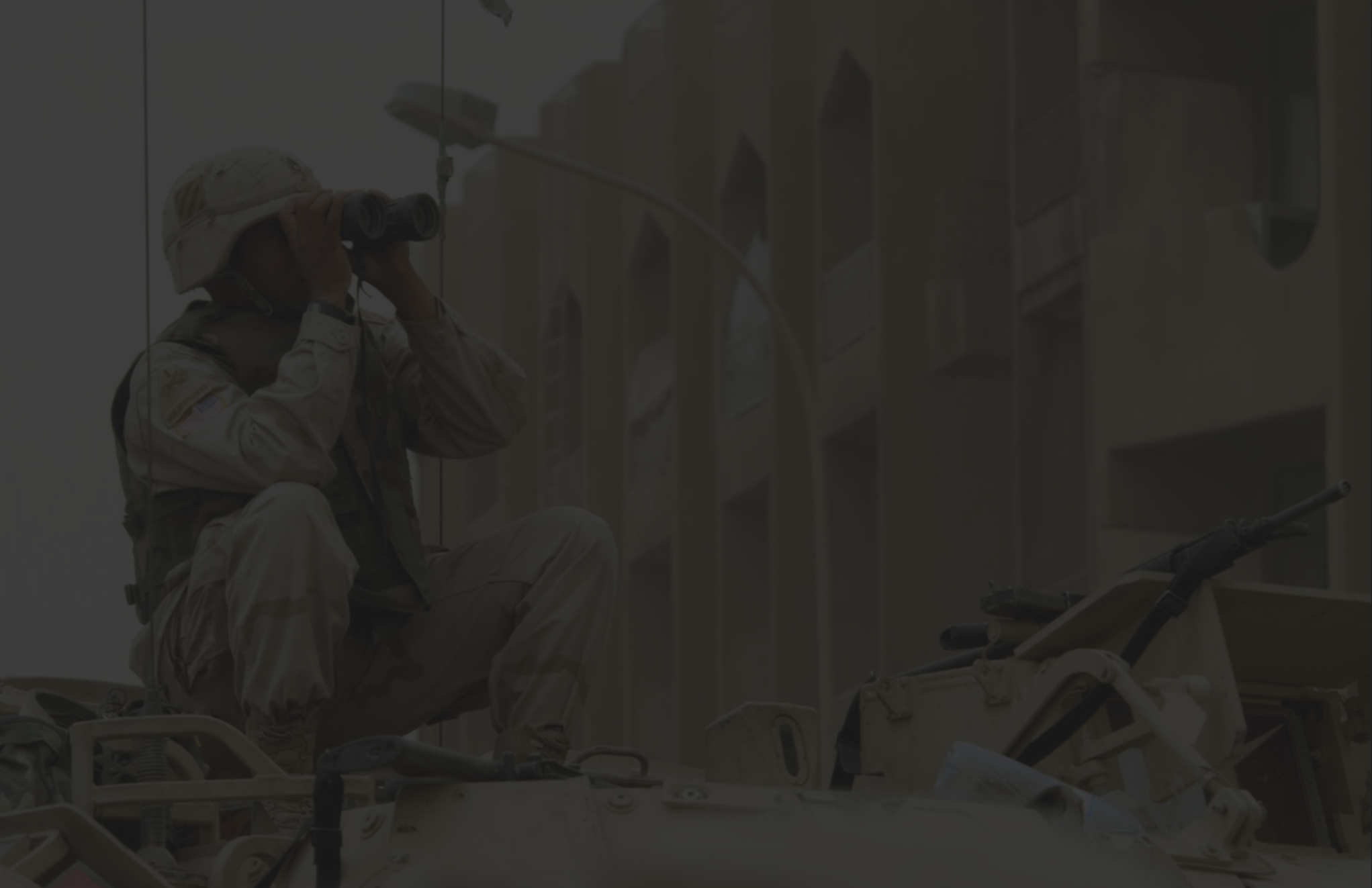
Featured Biographies
Your Story
Do you have a relative or someone close to you who served with the 3rd Infantry Division? Post on X (Twitter) using #ROTM and your post could be featured here!
Posts must be publicly viewable and NOT set to private sharing setting. Photos are encouraged!
A Company "Gators" 3-15 Infantry, 2nd Brigade, 3rd ID 20-year reunion. #ROTM pic.twitter.com/iLD78YBTnt
— Grunt315187 (@grunt315187) November 21, 2023
Served in 1st Plt D Co #1/41Inf of @3rd_Infantry attached to @1stArmoredDiv while at @FortRiley 96-99 #ROTM #DeathBeforeDishonor pic.twitter.com/OO8urQ0m4J
— James H (@JHensley_DPHS) November 21, 2023
#ROTM # Dogface Soldier June 2006 Sadr City pic.twitter.com/6SWwnOX8zJ
— tenaciouslee (@bigbrntruck) November 21, 2023
#ROTM https://t.co/kzvAnVP2NU pic.twitter.com/JplNDMjzAZ
— tony2x 🐊🏈 (@Free43941612) November 21, 2023
Dad was a Dogface Soldier in Germany. I grew up with Rocky. Really proud that @ArmyWP_Football is honoring #ROTM this year.
— alter Soldatenbär 🐻 (@barefootboomer) November 21, 2023
Returning from Korea rotation in 2018 with 1ABCT, 3ID. #ROTM pic.twitter.com/HqcrqdYZje
— Zach (@ZJSchmidt) November 21, 2023
OIF 3 3/15 inf 2nd Bde. OIV 1/30 inf. 2bde. #ROTM pic.twitter.com/naZ0o3rZ9C
— David Marone (@dm454ss) November 22, 2023
#ROTM Attached to 2-69. "Speed and Power" COS Kalsu OIF IX and Operation New Dawn. pic.twitter.com/Q0uUQR1s1u
— Mike (@WUPanthers4) November 22, 2023
#ROTM #GoArmy #BeatNavy pic.twitter.com/1U1LpjtMXZ
— Grunt315187 (@grunt315187) November 22, 2023
#ROTM 3/3 2/69 OIFIII Baquba and Ramadi
— N7Anderson🇺🇸 (@JAnderson269) November 22, 2023
SPEED AND POWER pic.twitter.com/O6CDverwmb
#ROTM 03 Invation 2 BCT 1-9FA #BATTLEKINGS pic.twitter.com/gZMnbh7VdO
— askKevin (@kocan610) November 24, 2023
Tikrit, Iraq circa 2005 1st BDE, 2/7INF #ROTM pic.twitter.com/AqMtsNCETH
— Michael Foss (@fubar_82) November 29, 2023
🎶 I wouldn't give a bean to be a fancy pants Marine. I'd rather be a Dogface Soldier like I am. 🎶
— Delegate Nick Allen (@NickAllenforMD) November 30, 2023
Here's a throwback to my LT days at Ft Stewart. I can't wait for this year's Army Navy game, where Army will be honoring the 3rd Infantry Division! #ROTM #BeatNavy pic.twitter.com/New9UpYrpW
I Was attached to 3rd ID during OIF, Thunder Run. My Great Grandfather was in the 3rd ID during WWI. He was in the Battle where the Division earned the nickname Rock of the Marne #ROTM This is a picture of his Artillery Brigade after the war. @3rd_Infantry @ArmyWP_Football pic.twitter.com/uWWk4xI9Id
— jjr78 (@jjr782) December 5, 2023
Last year on March 20 the invasion date for Iraq we held a ceremony at the Monument to place the blue & gold dog tags for SFC Cashe and the others who passed & served alongside him on that fateful day. SFC Smith is 2 tags to the left of his. #ROTM Go ARMY Beat NAVY! pic.twitter.com/LsRyxejgcI
— Iraq War Monument (@IraqWarMonument) December 8, 2023
My brothers and I. #ROTM #GoArmy pic.twitter.com/U7bQLtvhQw
— Tashel (@22Tashel) December 9, 2023
#ROTM Cco 11th Engineer battalion 1998-2001 3rd Infantry Division.
— Homer (@MarshallVet) December 9, 2023
Let’s go! #GoArmyBeatNavy @3rd_Infantry #ROTM #DogFaceSoldier #Sledgehammer pic.twitter.com/Vmot69mKG3
— C-HAM (@CHAM11) December 9, 2023
Served in the Raider Brigade call sign Raider 2 November OIF #1 pic.twitter.com/ZGbGaMSHHp
— Jimmy Dean Caldwell (@elkriversabot) December 8, 2023
#ROTM #SENDME Always Forward 🙏🏾 @ArmyWP_Football pic.twitter.com/nM19HKVWRc
— C L Y 🎃 (@shefwcly) November 21, 2023
Glad that @ArmyWP_Football is honoring @3rd_Infantry. Deployed with them in 2010 and made incredible memories the entire time...#ROTM pic.twitter.com/Zhj2rFd1fH
— Jeff “Beat Navy” Caslen (@CaslenJ) November 21, 2023
RIP to my battle buddy, SSG Nimo Taula #ROTM pic.twitter.com/2vm8uhK0Jx
— Dave Mentier (@DMentd101) November 21, 2023
#ROTM #SENDME 🙏🏾 Proud to be a dog face soldier pic.twitter.com/uiJSLj3IJK
— C L Y 🎃 (@shefwcly) November 21, 2023
My WIFE is a Dogface Soldier 😤❤️🫶🏾#ROTM#BeatEm https://t.co/uX0Gi3m0BZ pic.twitter.com/1Tv1CS04L8
— T2 (@TyhierT2) November 21, 2023
#ROTM pic.twitter.com/7Uz6OMnasq
— Zach (@ZJSchmidt) November 21, 2023
2 Dog Faced Soldiers. RIP Nick I miss you buddy. #ROTM pic.twitter.com/J0H5YkkzbF
— James (@Grizzy39ancient) November 22, 2023
My bro; 2nd BDE Spartan - “Whom shall I send? And who will go for us? Here I am. Send me!” Baghdad Thunder run. I was fortunate enough (Aviation POG that I was) to be in the box with him NTC for his final net call Cobra Team OC. Didn’t know how good we had it! #ROTM #BeatNavy pic.twitter.com/MWr947f8n6
— SnakDr (@crl2541) November 22, 2023
#ROTM
— IG: @QUANTEMRRANDB (@QUANTETHESINGER) November 22, 2023
Let’s go Army !!! pic.twitter.com/BcwzFSzAzL
My dad at the top center, with glasses during OIF (2003).#BEATNAVY#ROTM#SonOfADogFaceSoldier pic.twitter.com/nxiYioy7GU
— Nick Neely (@NNeely04) November 22, 2023
#ROTM My son Cameron Allen
— Mark Allen (@bearscoach2) November 23, 2023
My girlfriend at the time and now wife of 17yrs on the Fort Stewart Parade Field returning home from Iraq 2003 Invasion #ROTM #GoArmy pic.twitter.com/Z4Yizh6BdC
— askKevin (@kocan610) November 25, 2023
It’s THAT week… Beat em! #GoArmy #BeatNavy #ROTM #DogFaceSoldier pic.twitter.com/8PAWr2epVi
— AbbersMD (@AbbersMD) December 3, 2023
4th Battalion, 3rd ADA, 3rd ID 1991#ROTM pic.twitter.com/jMelxDdEh6
— Paul Hester (@PaulHes93632619) December 7, 2023
4-64, 1-64. ‘04-‘11 #ROTM #Tuskers pic.twitter.com/diMhlHCAwe
— YankeeVol (@DarrellGfromTN) December 8, 2023
2/37 AR 91-93. #CourageConquers #AbramsBest #ROTM pic.twitter.com/hwQIR0nnHP
— Little Enos Burdette 🇺🇸 (@plumber_vol) December 8, 2023
My favorite pic from the #DogfaceSoldier days. Camped out on lawn chairs on my buddy Mike’s tank out at Red Cloud Range.
— Danno E. Cabeza (@DannoECabeza) December 9, 2023
This was a good day.#GoArmy #BEATNavy #ROTM pic.twitter.com/KNn4Fc9DwM
The @WestPoint_USMA football team will be representing @3rd_Infantry DIV as they take on @NavalAcademy today! I’m proud to have served twice and deployed to Afghanistan with that great Division - proud to wear the patch in my right shoulder! #GoArmy #BEATNavy #ROTM #ArmyNavy pic.twitter.com/mCRfM6Az3l
— Amanda Azubuike (@AmandaAzubuike) December 9, 2023
Here’s Dad with 1-3 AVN back in the day. pic.twitter.com/Z5VfEjgF3O
— MaxHIMilian (Goblin Mode) (@MaxTE34) December 8, 2023
A Co 3-15 Infantry 1st Platoon. This photo was hours before the start of the invasion. #ROTM pic.twitter.com/ZqlgQcQjrw
— Grunt315187 (@grunt315187) November 21, 2023
My dad, Col. John A. Lucero. 2nd Brigade, 3rd Infantry Division. Kitzingen, Germany 1976-78. “One of the best assignments during my Army career.” #ROTM pic.twitter.com/ONrH1U8Eva
— Black & Gold Guru (@BlackGoldGuru) November 21, 2023
Let us never forget!!! RIP Sir! #ROTM Bandits Lead the Way! pic.twitter.com/kChA645J61
— Johnny D (@john_demarco80) November 21, 2023
My son served 21 years, most of them in the 3rd ID. Watched him go off to war when he was still a kid. I will definitely get emotional this year watching the game w/ those uniforms. Go Army! #ROTM #DogfaceSoldier https://t.co/PZvlY682yJ
— Just call ❌e bwana (@davidmaryann) November 21, 2023
Shout out to my wonderful husband @RyanErbe #GoArmy #BeatNavy #ROTM #3ID pic.twitter.com/mXjcPkLjmt
— Keeper of the Snacks 🌻 (@brookee_04) November 21, 2023
3-15 Infantry CSM Robert Gallagher. "CAN DO" #ROTM pic.twitter.com/XSV0ml9pOo
— Grunt315187 (@grunt315187) November 21, 2023
Proud of my daughter, my hero, my Dogface soldier. #ROTM #ArmyMom #LEOmom pic.twitter.com/4ntvFHWAYA
— Kristina Staudt (@KristinaStaudt) November 21, 2023
#ROTM a couple of Dogface Soldiers hunting the Iraqi Medina Division, 3-7 Cav, #Garryowen, March 2003. pic.twitter.com/a06vsc6hJ8
— Matthew Brady (@MatthewBra70735) November 22, 2023
#ROTM
— Gordon Eiland (@GordonEiland) November 22, 2023
Robert Eiland, 3rd Division, 7th Infantry regiment, 1941 to 1945. WOJG. North Africa, Sicily, Anzio, and finally to Berchtesgaden and Eagle's Nest. Two bronze stars with oak leaf clusters, Purple Heart, more. I am very honored and proud to call him my father. He was a… pic.twitter.com/7alNpwI35i
LOVED my time in 3ID #ROTM #WePierce pic.twitter.com/HbD33oVoCK
— YankeeVol (@DarrellGfromTN) November 22, 2023
I was with them in Iraq back 2009/2010
— Roy Reed (@rreed7975) November 22, 2023
"Your face is familiar... weren't you in the Third Division during the war?"
— Delegate Nick Allen (@NickAllenforMD) December 4, 2023
- F. Scott Fitzgerald, The Great Gatsby
Did you know the 3rd ID is mentioned in The Great Gatsby? When Nick and Gatsby first meet, they realized they both served in the division during WWI!#ROTM pic.twitter.com/UDtBZYdZef
I’m a proud @3rd_Infantry Dog Faced Soldier! Go @USArmy !! Beat @USNavy !! #ROTM https://t.co/BZEUOAl2tR pic.twitter.com/J1A0feC6kU
— Randy Dexter (@deviantdex) December 7, 2023
#ROTM pic.twitter.com/e847Xqrtwt
— Patton Battalion - USABOT (@PattonBattalion) December 8, 2023
Rock of the Marne. Go Army, Beat Navy! Patrick Kennedy, 3-63 Armor, 2nd Brigade, 3rd Infantry Division 1983-1990. #ROTM pic.twitter.com/uBrwHz8vrS
— Patrick Kennedy (@Kpatnan) December 8, 2023
Proud to have served with the 3rd Infantry Division.
— Tyrek Swaby (@TyrekSwaby) December 9, 2023
3ID, Afghanistan 2017-2018
Looking forward to rooting on @ArmyWP_Football today as they #BeatNavy #ROTM #GoArmy pic.twitter.com/eWwffFlZkC
C co 2/7 infantry
— Warren Davis (@wdavis_OpRP) December 8, 2023
02-04
My father I-1 76 Sprint Football All East Halfback.. 6 TDs v Navy 3 game winners did CDLT in the Audie Murphy Company ACo 15th INF Regiment in 1975..
— Michael Grimm (@Grimmer28) December 7, 2023
35 yrs later, proud to still represent the #ROTM. BEAT NAVY! pic.twitter.com/G00bEJ9l5U
— Charles Moore (@scarecrow8041) December 8, 2023

